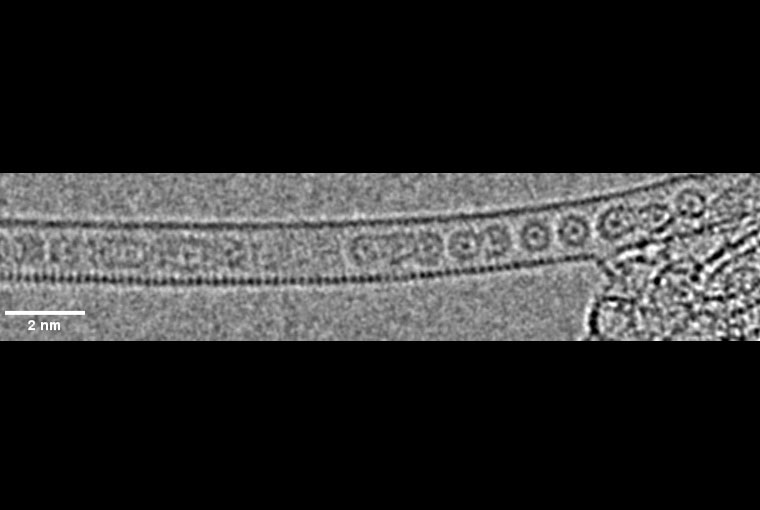| Jan 22, 2024 |
Trapping krypton atoms inside carbon nanotubes to form one-dimensional gas
(Nanowerk News) Scientists from the University of Nottingham’s School of Chemistry used advanced transmission electron microscopy (TEM) methods to capture the moment when krypton (Kr) atoms joined together, one by one, inside a carbon nanotube with diameter half a million times smaller than the width of a human hair.
|
|
The research has been published in the Journal of the American Chemical Society ("Atomic-Scale Time-Resolved Imaging of Krypton Dimers, Chains and Transition to a One-Dimensional Gas").
|
 |
| Krypton atoms joined together, one by one, inside a carbon nanotube. (Image: University of Nottingham)
|
|
The behaviour of atoms has been studied by scientists ever since it was hypothesized that they are the basic units of the universe. The movement of atoms has significant impact on fundamental phenomena such as temperature, pressure, fluid flow and chemical reactions. Traditional spectroscopy methods can analyse the movement of large groups of atoms and then use averaged data to explain phenomena at the atomic scale. However, these methods don’t show what individual atoms are doing at a specific point in time.
|
|
The challenge researchers face when imaging atoms is that they are very small, ranging from 0.1 – 0.4 nanometres, and they can move at very high speeds of around 400 m/s in the gas phase, on the scale of the speed of sound. This makes the direct imaging of atoms in action very difficult, and the creation of continuous visual representations of atoms in real-time remains one of the most significant scientific challenges.
|
|
Professor Ute Kaiser, former head of the Electron Microscopy of Materials Science group, senior professor at the University of Ulm, added: “We used our state-of-the-art SALVE TEM, which corrects chromatic and spherical aberrations, to observe the process of krypton atoms joining together to form Kr2 pairs. These pairs are held together by the van der Waals interaction, which is a mysterious force governing the world of molecules and atoms. This is an exciting innovation, as it allows us to see the van der Waals distance between two atoms in real space. It's a significant development in the field of chemistry and physics that can help us better understand the workings of atoms and molecules.”
|
|
The researchers utilised Buckminster fullerenes, which are football-shaped molecules consisting of 60 carbon atoms, to transport individual Kr atoms into nano test tubes. The coalescence of buckminsterfullerene molecules to create nested carbon nanotubes helped to improve the precision of the experiments.
|
|
Ian Cardillo-Zallo, a PhD student at the University of Nottingham, who was responsible for the preparation and analysis of these materials, says: “Krypton atoms can be released from the fullerene cavities by fusing the carbon cages. This can be achieved by heating at 1200 °C or irradiating with an electron beam. Interatomic bonding between Kr atoms and their dynamic gas-like behaviour can both be studied in a single TEM experiment.”
|
|
The group have been able to directly observe Kr atoms exiting fullerene cages to form a one-dimensional gas. Once freed from their carrier molecules, Kr atoms can only move in one dimension along the nanotube channel due to the extremely narrow space. The atoms in the row of constrained Kr atoms cannot pass each other and are forced to slow down, like vehicles in traffic congestion.
|
|
The team captured the crucial stage when isolated Kr atoms transition to a 1D gas, causing single-atom contrast to disappear in the TEM. Nonetheless, the complementary techniques of scanning TEM (STEM) imaging and electron energy loss spectroscopy (EELS) were able to trace the movement of atoms within each nanotube through the mapping of their chemical signatures.
|
|
Professor Quentin Ramasse, Director of SuperSTEM, an EPSRC National Research Facility, said: ‘By focusing the electron beam to a diameter much smaller than the atomic size, we are able to scan across the nano test tube and record spectra of individual atoms confined within, even if these atoms are moving. This gives us a spectral map of the one-dimensional gas, confirming that the atoms are delocalised and fill all available space, as a normal gas would do.’
|
|
The team plans to use electron microscopy to image temperature-controlled phase transitions and chemical reactions in one-dimensional systems, to unlock the secrets of such unusual states of matter.
|

